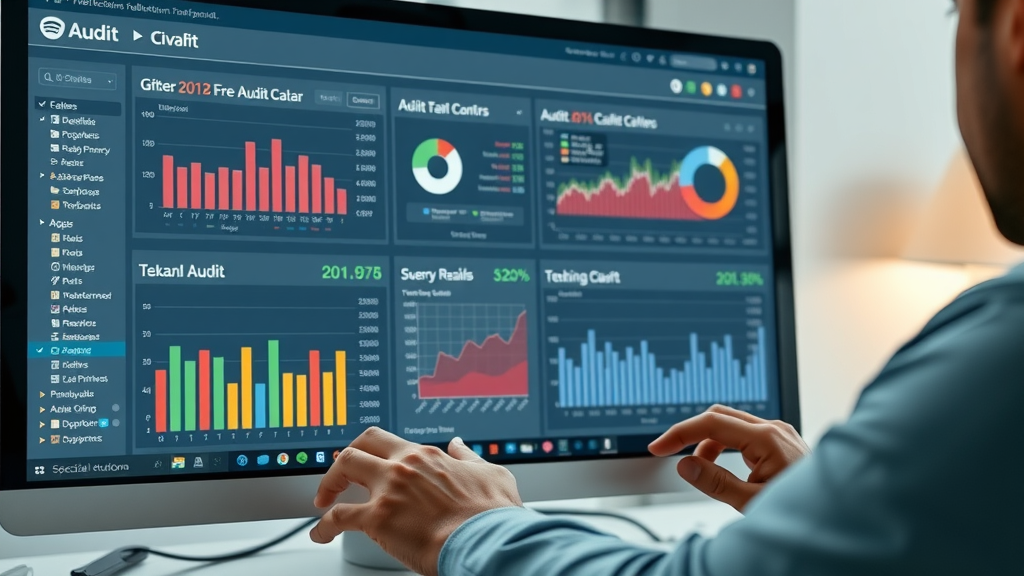Did you know that 93% of all online experiences start with a search engine, yet more than 60% of small businesses have no search engine optimization plan? You could be losing thousands—and even sabotaging your business’s future growth—if you’re making this all-too-common SEO mistake. In this comprehensive guide, you’ll uncover the hidden pitfalls of search engine optimization and discover actionable strategies to maximize your digital success. Read on to learn how to stop draining your marketing budget and start outranking the competition.
Why Ignoring Search Engine Optimization Is the Costliest Mistake in Digital Marketing
- According to a recent industry report, 93% of all online experiences begin with a search engine—yet over 60% of small businesses have no search engine optimization strategy. Discover how neglecting search engine optimization silently drains your marketing budget and hampers long-term growth.
If you’re not investing in search engine optimization , you’re practically invisible in the digital age. Search engines are the primary gateway for potential customers searching for products, services, or information. When your business lacks a targeted SEO strategy, you fail to appear in relevant search results, causing you to miss out on impressive amounts of organic search traffic—and, more importantly, revenue.
Consider this: Without robust engine optimization, your competitors who rank higher on the search engine results page are not just getting more clicks—they’re winning your customers and your profits. Over time, this neglect can chip away at your entire marketing spend, as paid ads only offer short-term traffic. Conversely, investing in a holistic search engine optimization process reaps ongoing rewards by boosting visibility, building authority, and lowering long-term acquisition costs.
Ignoring search engine optimization isn’t just a missed opportunity; it’s an expensive mistake that allows your marketing budget to silently slip through the cracks. It’s time to turn that around by putting SEO work front and center in your marketing strategy.

What Search Engine Optimization Really Means for Today’s Businesses
- Defining search engine optimization and why it’s critical for search engines and online visibility
- How engine optimization fuels sustainable growth
- Understanding the difference between search engine optimization and paid advertising
Search engine optimization (SEO) is the continuous process of optimizing your website content and technical setup so you appear higher on search engine results pages (SERPs), like those on Google, Bing, or Yahoo. When effectively implemented, SEO increases organic search visibility and draws steady traffic to your website—without ongoing advertising costs.
What sets SEO apart from paid advertising is its long-term impact. Paid ads disappear when your budget runs out, while strong engine optimization lays the foundation for sustainable, compounding growth. Ranking high in search engine results builds trust and credibility with users, driving more conversions at a lower acquisition cost and ensuring your business’s place in a competitive digital landscape.
Ultimately, mastering search engine optimization isn’t optional—it’s essential for any business wanting to thrive in the modern era. Understanding the intricacies of SEO work sets the stage for durable online authority and substantial return on investment.
For those looking to deepen their tactical understanding, exploring proven SEO strategies and techniques can provide actionable steps to strengthen your optimization efforts and avoid common pitfalls that hinder growth.
Search Engine Optimization: The Foundation of Digital Success
- History and evolution—how search engine optimization developed alongside search engines
- The impact of algorithm updates on engine optimization strategies
The roots of search engine optimization trace back to the 1990s, right alongside the rise of the earliest search engines. At first, basic tactics like keyword stuffing were all it took to rank high. However, as algorithms evolved, the competition for top spots on the engine results page has become more sophisticated—demanding a much deeper approach to SEO work.
Major algorithm updates, such as Google’s Penguin, Panda, and more recently, BERT and Helpful Content, have shifted the focus towards user experience, content quality, and site authority. These updates mean businesses must continually adapt their search engine optimization methods to keep pace with changing search engine criteria. Falling behind can result in steep drops in organic search visibility, impacting the traffic to your website and, ultimately, your bottom line.
Today, the best engine optimization strategies prioritize relevance, value, and technical excellence. In this fast-moving digital landscape, staying informed and agile with your SEO work is critical to maintaining—and growing—your visibility and authority.

The One Search Engine Optimization Mistake That Hurts Most: Overlooking Holistic SEO Work
- How focusing only on keywords undermines effective search engine optimization
- Integrating technical SEO, on-page SEO, and off-page strategies
Too often, businesses fall into the trap of treating search engine optimization as little more than keyword insertion. While keywords are critical, focusing exclusively on them means ignoring the holistic work required for success—such as technical SEO, on-page elements, and off-page factors like backlinks. This narrow view leaves your SEO strategy full of blind spots that stunt your engine-ranking potential.
Effective engine optimization demands an integrated approach. Technical SEO ensures your site is fast, crawlable, and secure; on-page SEO optimizes your content and page structure for both users and search engines; and off-page SEO builds authority through high-quality referrals and social media signals. Only by weaving these elements together can you rank higher on the search engine results page for valuable keywords and withstand algorithm updates.
A piecemeal approach will not produce sustainable results. Instead, businesses need to see SEO as an ongoing, multifaceted endeavor that requires regular attention and cross-functional expertise. When you neglect even one aspect, your rankings, traffic, and online revenue can plummet.
Spotting the Search Engine Optimization Blind Spots
- Common SEO work oversights: missing meta descriptions, weak title tags, user experience flaws, slow load times
Even well-intentioned SEO work can fall flat if you overlook key details. Common blind spots include missing or poorly written meta descriptions and title tags , both of which directly impact how your pages appear in search results and influence whether users click through to your website. Another frequent issue is subpar user experience—from slow page load times to clunky site navigation—which search engines interpret as a sign your content may not best serve users’ needs.
Technical oversights, such as broken links, missing alt text on images, and unoptimized mobile layouts, further hinder your chances to rank high on the engine results page. These technical SEO flaws are often invisible to the untrained eye but have a significant effect on crawlability and indexation, preventing your website from achieving its full organic search potential.
Proactively identifying and fixing these SEO work gaps with a comprehensive audit is essential. By paying close attention to technical details, search intent, and user experience, you’ll avoid the pitfalls that cause many sites to lose valuable traffic and revenue.

- Case study: How a lack of proper page SEO cost a business significant revenue A regional retailer spent heavily on paid ads, never realizing their poor page SEO —including missing meta descriptions, irrelevant title tags , and sluggish page speeds—was diverting thousands of visitors to the competition. After a detailed audit and a holistic SEO overhaul, they saw a 120% increase in organic traffic and a 60% boost in revenue within six months.
- Actionable Checklist: What your search engine optimization audit must include
- Review all meta descriptions and title tags for uniqueness and keyword alignment
- Check page speed and fix slow load times
- Audit internal and external links for broken or outdated URLs
- Analyze site architecture for user-friendly navigation
- Ensure mobile optimization is seamless across devices
- Verify XML sitemaps and schema markup are present and accurate
How Search Engine Optimization Connects with Search Engines
- Understanding search engines’ ranking criteria
- The science behind engine optimization matching search intent
To unlock the full potential of search engine optimization , you need to grasp how search engines—especially Google—evaluate and rank pages. Ranking criteria include site relevance, authority, quality backlinks, user engagement signals, and technical performance. The ultimate goal is to match user search intent: delivering the exact information or product users are seeking when they type a query into the engine results page.
Modern engine optimization places as much emphasis on user experience and content quality as it does on keyword placement. Search engines now utilize advanced algorithms and machine learning to assess whether your page truly satisfies a user’s needs, factoring in signals like click-through rate, dwell time, and bounce rate. Your SEO strategy must align every element—from structured data to long-form content—with what search engines consider trustworthy and useful.
At its core, SEO work is about ensuring your website is both discoverable and authoritative in the eyes of search engines and users alike. This synergy is what drives long-term, sustainable visibility, and growth in competitive industries.
Search engine optimization isn’t just about visibility—it’s about building trust and authority where it matters most, on search engines your customers use every day.
Mastering Keyword Research for Powerful Search Engine Optimization
- Step-by-step guide: Conducting effective keyword research to align with search engine and user intent
- Best tools for keyword research and how to interpret data
Comprehensive keyword research is the backbone of successful search engine optimization. It’s not just about picking the words you think people use—it’s about uncovering exactly how users search and tailoring your SEO work to solve their problems. Begin by brainstorming broad terms related to your business, then narrow down to more specific, long-tail keywords that capture user intent.
Utilize top keyword research tools like Google Keyword Planner, SEMrush, Ahrefs, and Moz to find high-volume, low-competition terms. Analyze the keyword difficulty score, search trends, and competitor rankings to refine your target list. Pay special attention to keywords that align with both your products/services and the topics your target audience actively searches for.
Finally, group your keywords by search intent—informational, navigational, or transactional—and map them to relevant pages or blog posts. Regularly reviewing and updating your keywords ensures your engine optimization strategy adapts to changing trends and emerging opportunities.

| SEO Tool | Keyword Research | Page SEO Assessment | Technical SEO Features |
|---|---|---|---|
| SEMrush | Advanced | Comprehensive | Site Audit, Crawlability, Backlink analysis |
| Ahrefs | Robust | In-depth | Technical audit, Link reports |
| Google Search Console | Basic | Performance tracking | Crawl errors, Mobile usability |
| Moz | Good | On-Page Grader | Site crawl, Page optimization |
Video: Walkthrough of a keyword research process with real-world examples
For best results, watch tutorials demonstrating how to identify, prioritize, and implement keywords into your content for improved search engine rankings. Real-world case studies will illustrate how keyword research impacts your SEO results page by boosting your online presence and usability.
Essential On-Page SEO Elements: Enhancing Search Engine Optimization
- Crafting compelling title tags and meta descriptions
- Optimizing content for keywords while focusing on user experience and readability
Outstanding on-page SEO is vital for effective search engine optimization. Your title tag and meta description are the first things users—and search engines—see on the results page. These elements should be both keyword-optimized and engaging, clearly communicating the value of the page.
But on-page work doesn’t end there. Your content should naturally incorporate target keywords without sacrificing readability or value. Proper headings (H1, H2, H3) structure your content for both users and search engines, while internal links connect related topics, helping users stay engaged and guiding crawlers for improved indexation. Additionally, balancing keyword density and focusing on authentic user experience signals to Google that your content is not only relevant but truly helpful.
Visual content matters, too. By using descriptive img tags and alt text, you enhance both accessibility and SEO, ensuring images contribute to the page’s relevance. Ultimately, on-page SEO ties your entire engine optimization strategy together—helping you rank high and convert visitors more effectively.

Checklist: Best On-Page SEO Practices for Effective Engine Optimization
- Use target keywords in your title tag, meta description, and headers (H1-H3)
- Ensure image files include descriptive img tags and relevant alt text
- Structure content logically with short, scannable paragraphs and bullet points
- Optimize for mobile responsiveness and fast loading times
- Incorporate internal and external links to support topic relevance and authority
- Maintain a keyword density of 1-2% to satisfy search engines without keyword stuffing
Technical SEO: The Backbone of Search Engine Optimization
- Key elements: Website speed, schema markup, XML sitemaps, SSL, crawlability
- How technical SEO issues impact search engine rankings
Without solid technical SEO , your content may never make it to the search engine results page. Technical SEO focuses on how well your website can be crawled, indexed, and displayed by search engines. This includes factors like website speed, security (SSL), schema markup, XML sitemaps, and ensuring all pages are accessible to search bots.
Failing to address technical SEO issues—such as slow website performance, missing HTTPS, or poorly structured sites—can seriously damage your engine rankings. Even the best content can go unnoticed if search engines can’t crawl or understand it efficiently. Prioritizing technical optimization ensures your SEO work lays a strong foundation for every other element of your strategy.
Investing in technical SEO isn’t just about compliance; it’s about maximizing your online market share and ensuring you don’t leave easy rankings—and revenue—on the table.

How to Conduct a Technical SEO Audit for Ultimate Engine Optimization
- Tools and checklists for beginners and pros alike
- Prioritizing fixes for maximum ROI
Conducting a thorough technical SEO audit starts with using professional-grade tools like Screaming Frog, SEMrush Site Audit, and Google Search Console. Begin by assessing crawl errors, broken links, and XML sitemap accuracy. Next, review schema markup and metadata to ensure your content is easily interpreted by search engines.
Speed matters—use PageSpeed Insights or GTmetrix to pinpoint load time issues. Finally, confirm that your site uses HTTPS, is mobile-friendly, and that all redirects follow best practices. Prioritize fixing high-impact issues first, as these will yield the greatest improvements in engine ranking and organic search traffic. Regular audits should become a standard part of your engine optimization workflow.
With a systematic approach, you can resolve even complex technical SEO challenges and keep your website in top condition for ongoing ranking success. This is a crucial element in any robust SEO strategy .
Page SEO vs. Off-Page SEO: Maximizing Your Search Engine Optimization Results
- Difference between on-page SEO (title tag, meta description, content structure) and off-page factors (backlinks, social media signals)
- Why both are essential for robust engine optimization
Page SEO focuses on elements within your control, such as title tags , meta descriptions, content structure, internal linking, and mobile optimization. These details make your pages appealing to both users and search engines, helping you appear more prominently in engine results.
In contrast, off-page SEO addresses external factors influencing trust and authority—primarily by building backlinks from reputable sites, cultivating positive social media signals, and earning strong online citations. These activities send validation signals to search engines, indicating your site’s popularity, relevance, and trustworthiness beyond your own web domain.
Excellence in both page SEO and off-page SEO is essential. While a keyword-optimized page structure might get you noticed, a strong off-page profile propels you further up the search engine rankings, creating a durable competitive advantage.

Video: Building Quality Backlinks—The #1 Off-Page SEO Activity for Search Engine Optimization
Building high-quality backlinks is the most powerful off-page SEO strategy. Watch expert videos to learn practical outreach techniques, link-building tactics, and how to monitor your backlink profile for sustainable search engine optimization growth.
Why User Experience Is Central to Search Engine Optimization
- How user experience signals are interpreted by search engines
- Ways to improve navigation, design, and engagement metrics
User experience (UX) is now a major ranking factor in search engine optimization. Search engines like Google increasingly assess how users interact with your website: Are they finding what they need easily? Is your site mobile-friendly? Do pages load quickly and offer clear, intuitive navigation?
Improving UX isn’t just about aesthetics. It means simplifying site architecture, ensuring clear calls to action, speeding up load times, and making your content accessible on any device. Better UX keeps visitors engaged longer, lowers bounce rates, and signals to search engines that your site deserves to rank higher on results pages.
Focus on building seamless user journeys to foster engagement, improve engine rankings , and turn new visitors into loyal customers. Remember: What’s good for your user is good for search engine optimization.

Great search engine optimization puts users at the center because search engines do too.
Social Media and Search Engine Optimization: Do They Work Together?
- The relationship between social media signals and search engine rankings
- Case studies: How brands leveraged social media for better SEO results
While social media signals are not direct ranking factors, there’s a powerful link between your social media presence and search engine optimization results. Active social sharing amplifies your content’s reach, driving more traffic to your website and increasing positive brand mentions and backlinks—all of which indirectly boost engine rankings.
Case studies show that brands that align their social media strategies with SEO work generate more earned media coverage and natural backlinks, which in turn help pages climb higher on search engine results pages. Social platforms are also important for content distribution, audience engagement, and reputation building—all crucial for holistic search engine optimization.
Integrating social media into your SEO strategy not only expands your digital footprint but also improves your ability to attract and convert high-value customers from multiple channels.

Checklist: Integrating Social Media with Your Search Engine Optimization Strategy
- Share SEO-optimized blog posts and pages regularly across social platforms
- Encourage employees and partners to amplify content shares
- Collaborate with influencers to broaden reach and earn links
- Monitor social mentions and use positive feedback to inform SEO content updates
- Track referral traffic from social media to identify high-impact opportunities
SEO Work in Action: Real-Life Examples of Search Engine Optimization Turnarounds
- Before-and-after insights: How businesses fixed fatal SEO mistakes and saw exponential growth
- Engine optimization strategies used for recovery
Consider the example of an e-commerce retailer who had neglected basic SEO work for years. After losing organic traffic to newer competitors, they started with a complete site audit, rebuilt their technical SEO foundation, revised all title tags and meta descriptions for clarity and keyword focus, and invested in content that answered users’ questions directly. The turnaround: A 5x increase in organic website visits and a threefold rise in conversion rates within a single year.
Another local business transformed their fortunes by optimizing their Google Search presence—improving NAP (name, address, phone) consistency, integrating schema markup, and encouraging online reviews. These steps pushed them into the coveted local pack, doubling their in-store foot traffic in just a few months.
These real-world stories illustrate how even seemingly minor SEO mistakes add up. Proactive, full-spectrum engine optimization has the power to revive struggling businesses and cement long-term growth.
Deep Dive: Google Search and Search Engine Optimization Best Practices
- How Google search evaluates websites
- Advanced tactics: Schema markup, EAT (Expertise, Authoritativeness, Trustworthiness) for search engine optimization
Understanding how Google Search evaluates sites sharpens your SEO efforts. Google’s algorithms reward pages that offer expertise, authoritativeness, and trustworthiness (EAT), verified by quality content, reputable authorship, and references from credible sources. Leveraging advanced tactics—like adding schema markup—helps Google interpret your data, enabling rich snippets on the search engine results page and improving click-through rates.
Key actions include: producing in-depth, original content; citing reputable sources; using schema.org markup to clarify business details and internal links; and maintaining transparent privacy practices. When users and algorithms identify your site as a reliable voice in your industry, you’re far more likely to rank high and attract valuable organic traffic to your website.
Commit to these search engine optimization best practices to future-proof your digital brand and achieve sustainable ranking wins in an ever-evolving landscape.

Answering Major Search Engine Optimization Questions
What is of search engine optimization?
- Search engine optimization is the process of optimizing your website and content to increase its visibility in search engines like Google, Bing, or Yahoo, aiming to drive organic (unpaid) traffic and improve rankings for targeted keywords.
Search engine optimization is crucial for boosting your website’s visibility, as it helps ensure your content appears for relevant queries on major search engines. By strategically optimizing various components, from metadata to link profiles, you can attract ongoing organic search visitors without relying on paid ads.
How to do SEO for beginners?
- Beginners should start with foundational steps: conducting keyword research, on-page optimization (titles, meta descriptions), creating quality content, improving site speed, and building relevant backlinks. Using free tools like Google Search Console is recommended.
For SEO beginners, start with keyword research to identify what your target audience is searching for. Next, craft compelling title tags and meta descriptions, produce high-quality and relevant content, optimize page speed, and build backlinks from trustworthy websites. Free resources like Google Search Console help you monitor search engine performance and track progress effectively.
Can I do SEO on my own?
- Yes, you can do SEO yourself by following online guides and implementing best practices. Start small with basic on-page and technical optimization before exploring more advanced SEO strategies.
Absolutely! Many small business owners successfully handle search engine optimization in-house, leveraging online tutorials, SEO tools, and basic best practices. By taking a systematic, step-by-step approach, you can improve your engine ranking results—even without a large marketing team.
What are the 4 types of SEO?
- The four types of SEO are on-page SEO, off-page SEO, technical SEO, and local SEO. Each focuses on different elements to boost your website’s ranking in search engines.
The four pillars of search engine optimization are on-page SEO (page content and structure), off-page SEO (backlinks and external factors), technical SEO (site speed, sitemaps, security), and local SEO (boosting visibility in local search results). Mastering all four maximizes your site’s potential to rank higher for relevant queries.
The Pillars of Sustainable Search Engine Optimization Success
- Continuous learning and adaptation with algorithm changes
- The necessity of analytics and tracking for ongoing engine optimization
Long-term success in search engine optimization demands continuous improvement. Algorithm updates, emerging search trends, and shifting user behaviors mean your SEO work is never truly “finished.” Regularly revisiting analytics data—such as tracking engine rankings, bounce rates, and search traffic—helps you identify what’s working and where adjustments are needed.
Leverage tools like Google Analytics, Google Search Console, and third-party SEO platforms to monitor progress and set actionable goals. By staying agile and investing in ongoing education, you’ll keep your search engine optimization strategy ahead of the competition and secure your place at the top of the results page.
The best SEO practitioners are proactive learners—always ready to adapt, experiment, and implement the latest marketing strategies for maximum impact and sustainable growth.

Recap: The Key Components of Effective Search Engine Optimization
- Main takeaways from the article:
- Why holistic search engine optimization is essential
- The costliest mistakes and how to fix them
- Core strategies for the best results
Holistic search engine optimization combines technical, on-page, and off-page strategies for lasting results. Avoid the costliest mistake—neglect—by maintaining a comprehensive, up-to-date SEO approach. Focus on core tactics: keyword research, technical audits, compelling content, backlinks, and strong user experience, and your search engine ranking will climb.
Successful SEO work is an ongoing process of analysis, adjustment, and adaptation. Incorporate analytics, follow best practices, and never stop learning to maintain your hard-won visibility and market share.
If you follow these strategies, you’ll not only stop losing money—you’ll set your business up for scalable, long-term digital growth.
If you’re inspired to take your SEO journey even further, consider exploring what it takes to truly excel in this dynamic field. Delving into how to become an SEO expert can unlock advanced skills, strategic thinking, and a deeper understanding of the ever-evolving search landscape. Whether you’re a business owner or an aspiring professional, mastering the art and science of SEO opens doors to new opportunities and sustainable growth. Take the next step and empower yourself with the expertise to drive measurable results and stay ahead of the competition.
Frequently Asked Questions About Search Engine Optimization
- How long does it take to see results from search engine optimization?
- SEO is a long-term strategy—a well-implemented campaign typically produces noticeable improvements in engine rankings and organic search traffic within 3-6 months. Results may appear sooner for less competitive keywords or with significant technical improvements.
- Is it worth investing in hiring an SEO agency?
- If you lack in-house expertise or time, a reputable SEO agency can accelerate your search engine optimization progress by offering specialized strategies, regular audits, and measurable results. However, always verify an agency’s track record before investing.
- How important is content quality for search engine optimization?
- Content quality is a top-ranking factor. Well-researched, relevant, and engaging content satisfies search intent, keeps users on your site longer, and builds authority—ultimately driving better engine results and higher rankings.
Ready to Stop Losing Money on Search Engine Optimization?
- Ready to grow your business? Book your free marketing strategy session with our team today. https://aaronmills.marketing/
To deepen your understanding of search engine optimization (SEO) and enhance your digital marketing strategies, consider exploring the following resources:
-
“SEO Starter Guide: The Basics” : This comprehensive guide by Google offers foundational insights into SEO practices, helping you improve your site’s presence in search results. ( developers.google.com )
-
“What Is SEO - Search Engine Optimization?” : Search Engine Land provides an in-depth look at various SEO types and specializations, including technical, on-site, and off-site optimization strategies. ( searchengineland.com )
By delving into these resources, you’ll gain valuable knowledge to refine your SEO approach and drive meaningful results for your business.
 Add Row
Add Row  Add
Add 



Write A Comment